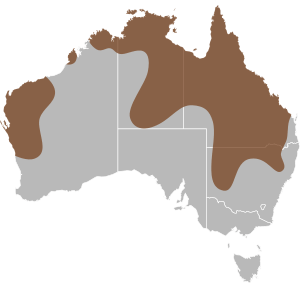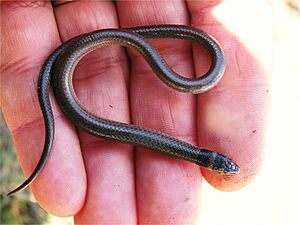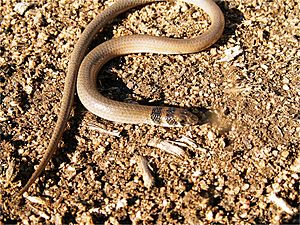Excitable delma facts for kids
Quick facts for kids Excitable delma |
|
|---|---|
 |
|
| Photograph by Stewart MacDonald | |
| Conservation status | |
| Scientific classification | |
| Genus: |
Delma
|
| Species: |
tincta
|
 |
|
The excitable delma (Delma tincta) is a special kind of lizard found only in Australia. It belongs to a family called Pygopodidae. It's called 'excitable' because it has a super active way to defend itself! When it feels scared, it jumps around wildly, changing direction with each leap to confuse predators.
This lizard is long and thin, and it doesn't have legs! Over many years, it evolved to lose its limbs. You can find it in many different places across Australia, but it loves to hide. Since it's active at night, it's quite rare to spot one in the wild.
The excitable delma is small to medium-sized. Its tail is very long, about three to four times longer than its body! A typical excitable delma is about 250 to 300 millimeters (10 to 12 inches) long. This legless lizard is an insectivore, meaning it eats insects. It finds its meals by moving through grass, under logs, in loose soil, and under rocks. Like all pygopodids, the excitable delma lays eggs, usually just two at a time.
Contents
What is the Excitable Delma?
The excitable delma was first officially named Delma tincta in 1888 by a scientist named De Vis. Later, in 1901, another scientist named Garman called it Delma reticulata, but the original name stuck.
There are many different kinds of delmas. Some of these include:
- Marble-faced delma (Delma australis)
- Rusty-topped delma (Delma borea)
- Pilbara delma (Delma elegans)
- Fraser's delma (Delma fraseri)
- Striped legless lizard (Delma impar)
- Peace delma (Delma pax)
- Collared delma (Delma torquata)
How to Describe the Excitable Delma?
The excitable delma looks a lot like a snake. This is because, over time, it completely lost its legs through evolution. It has a very long, thin body with a tail that can be three to four times longer than its body. Its snout, or nose, is also rounded.
An adult excitable delma's body (from snout to where the tail begins) is about 80 to 90 millimeters (3 to 3.5 inches) long. Its tail can stretch out to about 240 millimeters (9.5 inches)! Young delmas are smaller, with bodies around 40 millimeters (1.5 inches) and tails up to 136 millimeters (5 inches). Compared to other delma lizards, the excitable delma is small to medium-sized.
The excitable delma's body is usually an olive green to grey-brown color. Its belly is a white-cream color. It has special scales on its body and head. On its upper head and neck, it has three clear black markings. These black marks are broken up by four yellow bands. The first yellow band is on its snout, the second is before its eye, the third is behind its eye, and the last one is across the back of its head. These markings are much clearer and brighter on young delmas.
Where Does the Excitable Delma Live?
At first, people thought the excitable delma only lived in Queensland and the northern part of New South Wales. But studies have shown this isn't true! This legless lizard has now been seen in five of Australia's eight states and territories.
You can find the excitable delma in these areas:
- Queensland: It's found all over this state.
- New South Wales: Mostly in the northern parts.
- Northern Territory: In the southern two-thirds of the territory.
- South Australia: In the north-eastern corner, stretching towards the south-west.
- Western Australia: From the central west up to the north.
In 1991, a scientist named Glenn M. Shea studied ten excitable delma specimens found across Australia. Seven were from Queensland, one from New South Wales, and one was in a museum in Western Australia. The last one was from 'Mt. Barker,' which could be near either Adelaide, South Australia, or Perth, Western Australia.
The excitable delma lives in many different places. These include dry forests, sandy deserts with spinifex grass, and rocky areas. They usually hide under loose rocks, logs, or other things lying on the ground. Sometimes, they can be found just under the surface of the soil.
How Does the Excitable Delma Behave?
The excitable delma gets its name because it's the most active lizard in the pygopodid family. It has a special defense mechanism where it jumps and twists its body in an amazing acrobatic display. This helps to scare or confuse predators. When the excitable delma feels threatened, it uses its long tail to push itself upwards, lifting its whole body off the ground. As it leaps, it changes direction with each jump in a wild, unpredictable way.
Scientists at the University of California in Berkeley watched an adult excitable delma in a controlled environment. Even without anything scaring it, the delma was filmed jumping more than 30 times! These jumps reached heights of 11 to 15 centimeters (4 to 6 inches) and lasted about 0.41 to 0.45 seconds from when it lifted off to when it landed.
The excitable delma moves through its different habitats using a special kind of movement called saltation. This is a type of side-pushing movement. Saltation is common in animals without limbs, and for pygopodids, it's a way to react to predation. It might look like they are trying to escape, but it's actually a specific way they move. The jumping helps them move their body faster. This movement starts in the tail, and the lizard has evolved to push itself forward at a 45-degree angle.
Another way delma lizards defend themselves is by making sounds. Like other lizards in the pygopodid family, they can vocalize when they feel threatened.





